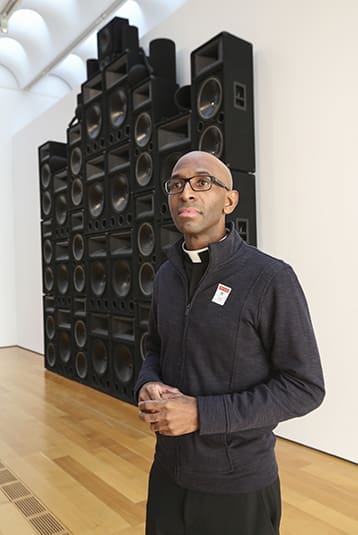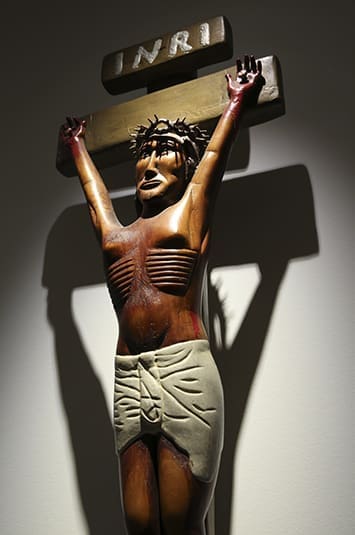This mixed media piece entitled, “Once Something Has Lived It Can Never Really Die,” is the work of the late artist Ronald Lockett. It is connected to the reflection, written by Our Lady of Mercy High School theology chair, Franck Launay-Fallasse, for Station Fourteen at the High Museum, Jesus is Placed in the Tomb. Photo By Michael Alexander
Atlanta
Archdiocese partners with High Museum for Stations of the Cross devotion
By ANDREW NELSON, Staff Writer | Published March 19, 2020
ATLANTA—Drawing from a diversity of art and reflections, believers can trace the final hours of Jesus’ life in a new Stations of the Cross devotion.
Pieces from the High Museum of Art’s collection reveal religious expressions from unexpected sources: contemporary photography, an abstraction of silhouetted figures, a painting with a nod to Mexican art and the tradition of memento mori (a reminder of the inevitability of death).

Father Desmond Drummer, pastor of Most Blessed Sacrament Church, Atlanta, and chaplain at Our Lady of Mercy High School, Fayetteville, stands before the artistic work of Nadine Robinson’s “Coronation Theme: Organon.” The speakers sound system and mixed media piece is connected to his reflection on Station Thirteen at the High Museum, Jesus Dies on the Cross. Photo By Michael Alexander
Accompanying the art are reflections written by parish ministry leaders, Atlanta’s bishops, a religious sister, a priest and deacon.
Jayna Hoffacker, program coordinator for Justice and Peace Ministries of the archdiocese, is one of the organizers. She predicted the art and the reflections may stretch people’s imaginations.
“We want people to be exposed to the diversity in the art world and the archdiocese,” said Hoffacker.
Father Desmond Drummer, pastor of Blessed Sacrament Church, Atlanta, and chaplain at Our Lady of Mercy High School, Fayetteville, assisted in organizing the project.
The program is online at the Blessed Sacrament Church website. Viewers can experience a virtual Stations of the Cross prayer and meditation while the High Museum is closed due to COVID-19 precautions.
“As with every other piece of this project, there’s really no right or wrong way to do it,” Hoffacker said.
The selections are from the nearly 17,000 pieces at the High Museum. The two spent a couple hours in January at the Midtown museum, reviewing the art and mapping how pilgrims could navigate the collection on a spiritual tour.
The art isn’t typical in depicting this popular Lenten devotion. There are two overtly religious themed pieces included—the 1650 oil painting by Nicolas Tournier of Peter denying Christ, and “Jesus on the Cross,” carved by African American folk artist Ulysses Davis.
Otherwise, the works portraying the arrest, journey to Golgotha and death of Jesus spotlight varied artists from seven collection areas: African art, American art, decorative arts and design; European art, folk, modern and contemporary art; as well as photography.
The pieces are “a little more imaginative in what you’re seeing and putting yourself in that place or imagining Jesus in that place,” said Hoffacker.
The devotion of the Stations of the Cross dates back more than 500 years. Pilgrims prayed in Jerusalem at what would become a tradition of 14 stations tracing the final hours of Jesus’ life. Stations were later created in Europe to mirror the Jerusalem landmarks.
In this new guide, believers experience the scriptural stations of the cross. According to the U.S. Conference of Catholic Bishops, this expression of reliving the end of Jesus’ life began on Good Friday, 1991, when it was observed by St. John Paul II. They are an alternative to the traditional stations, relying more on the scriptural accounts of Christ’s passion.

The wooden depiction of “Jesus on the Cross” is connected to Auxiliary Bishop Joel M. Konzen’s reflection on Station Ten at the High Museum, Jesus is Crucified. The wooden piece was created by the late barber and self-taught artist, Ulysses Davis. By Michael Alexander
Museum excursion becomes a pilgrimage
An 1850 wooden side chair represents the fifth station, where Jesus is judged by Pilate. It fell to Lauren Morton, the director of campus ministry, Cristo Rey Atlanta Jesuit High School, to draw out a religious theme.
Writing in the first person, Morton described finding “the seat of judgment.”
Morton, 39, grew up in museums. Her summers were spent immersed in New York City museums.
“Arts and culture is a big, big part of my family, and it made a difference,” she said.
The quiet of museums is a refuge for her as an adult “as a place for peace, for prayer and for calm.”
Morton took a student intern along with her to the museum on a recent Friday afternoon to see her assigned piece. Even the outing became a pilgrimage, as the two spent the afternoon exploring.
“It was kind of an educational moment for both in sharing and building community. We ventured around and went to see other pieces, to see other parts of the museum as well,” she said.
Writing in the first person, Morton described finding “the seat of judgment.”
The Scripture from St. Mark about the exchange between Jesus and Pontius Pilate, for Morton, made her think how people claim their identity in the face of others’ misguided views.
“I’m not going to put that on me. I don’t own the narrative that you make about me, I know who I am,” she said.
Finding Jesus in the abstract
Jess Butrum works as the youth minister at All Saints Church, Dunwoody. Writing has been something he has long relished, earning a college degree in creative writing.

This side chair that dates back to 1850 is associated with Station Five at the High Museum, Jesus is Judged by Pilate. The reflection for the fifth station was written by Lauren Morton, director of Campus Ministry, Cristo Rey Atlanta Jesuit High School. Photo By Michael Alexander
At first glance of the art, he was paralyzed by the abstract expressionist painter Norman Wilfred Lewis.
“There is some shadow on the ground. I didn’t even know where to go with this. I had no response to this initially. I was wrecking my brain,” said Butrum.
The “splash of red” in the corner of the artwork released his creativity, he said.
He reflected on Jesus beaten at the command of Pilate, as told in the Gospel of St. John.
Butrum’s writing may be what people need to hear on days when things are going against them. Butrum said he wrote for people to realize how the Passion wasn’t something Jesus wanted, but what he endured “because of love for you, and I and all of mankind.”
Knowing Jesus persisted makes him relatable for people who go through troubled times and see it through to the end, he said.



